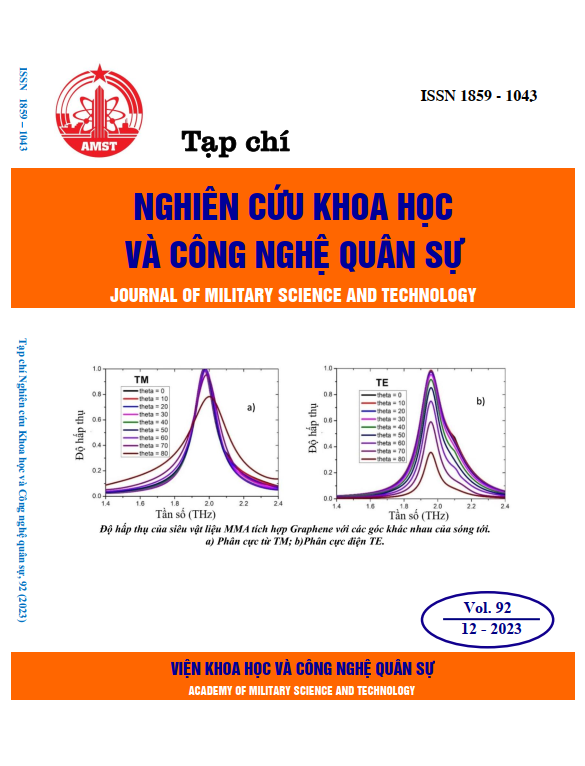Lower driving voltage for V-shaped Electrothermal Microactuator based on the surface sputtering process
317 viewsDOI:
https://doi.org/10.54939/1859-1043.j.mst.92.2023.21-29Keywords:
Surface sputtering process; Resistivity; V-shaped Electrothermal Microactuator; SOI-MEMS micromachining.Abstract
This research proposes a method to reduce the resistance of silicon-based V-Shaped Electrothermal Microactuator (VEM) by applying a surface sputtering process. Four VEM counterparts are fabricated by the traditional SOI-MEMS technology, three of them are processed additionally by sputtering technique to deposit a thin layer of platinum on top surface with different sputtering time, and the other is non-sputtering. Measured results show that the average resistance of sputtered structures is approximately 1.16, 1.55 and 2.4 times lower than the non-sputtering sample, corresponding to the sputtering time of 1.5, 3 and 6 minutes. The displacements of the VEM are calculated and simulated to evaluate the advantages of the sputtering method. The simulation result confirmed that the maximum displacement of sputtered VEM is almost 1.45 times larger than that of non-sputtering ones in the range of voltage from 8 V to 20 V. The experimental displacements are also measured to validate the better performance of sputtered samples.
References
[1]. Fang, K.; Hu, T.; Jiang, X.; Zhao, Y. “Research on a MEMS based encrypted rotary safety and arming device”, Sensor Actuators A Phys, 301, 111781 (2020). DOI: https://doi.org/10.1016/j.sna.2019.111781
[2]. Zhaoxin Lao, Neng Xia, Shijie Wang, Tiantian Xu, Xinyu Wu and Li Zhang, “Tethered and Untethered 3D Microactuators Fabricated by Two-Photon Polymerization: A Review”, Micromachines (Basel), 12(4): 465 (2021). DOI: https://doi.org/10.3390/mi12040465
[3]. Zhang Z., Yu Y., Liu X., Zhang X., “Dynamic modelling and analysis of V- and Z-shaped electrothermal Microactuators”, Microsystem Technologies., 23(8), 3775–3789 (2017). DOI: https://doi.org/10.1007/s00542-016-3180-0
[4]. Z. Zhang, Y. Yu, X. Liu and X. Zhang, “A comparison model of V- and Z-shaped electrothermal Microactuators”, 2015 IEEE International Conference on Mechatronics and Automation (ICMA), Beijing, 1025-1030 (2015). DOI: https://doi.org/10.1109/ICMA.2015.7237626
[5]. Li, X.; Zhao, Y.; Hu, T.; Xu, W.; Zhao, Y.; Bai, Y.; Ren, W, “Design of a large displacement thermal actuator with a cascaded V-beam amplification for MEMS safety-and-arming devices”, Microsystem Technologies, 21, 2367–2374 (2015). DOI: https://doi.org/10.1007/s00542-015-2447-1
[6]. Dongpeng Zhang, Anjiang Cai, Yulong Zhao and Tengjiang Hu, “Macro Modeling of V-Shaped Electro-Thermal MEMS Actuator with Human Error Factor”, Micromachines, 12, 622, (2021). DOI: https://doi.org/10.3390/mi12060622
[7]. HamedMajidi Fard-VatanMohsenHamedi, “Design, analysis and fabrication of a novel hybrid electrothermal microgripper in microassembly cell”, Microelectronic Engineering Volume 231, 15, 111374, (2020). DOI: https://doi.org/10.1016/j.mee.2020.111374
[8]. Guoning Si,Liangying Sun, Zhuo Zhang and Xuping Zhang, “Design, Fabrication, and Testing of a Novel 3D 3-Fingered Electrothermal Microgripper with Multiple Degrees of Freedom”, Micromachines, 12(4), 444, (2021). DOI: https://doi.org/10.3390/mi12040444
[9]. Hu T., Zhao Y., Li X., Zhao Y., Bai Y., “Integration design of MEMS electro-thermal safety-and-arming devices”. Microsyst. Technol., 23(4), 953–958, (2017). DOI: https://doi.org/10.1007/s00542-016-2901-8
[10]. Shen, X.; Chen, X., “Mechanical performance of a cascaded V-shaped electrothermal actuator”, Int. J. Adv. Robot. Syst., 10, 379, (2013). DOI: https://doi.org/10.5772/56786
[11]. Park, J.S.; Chu, L.L.; Oliver, A.D., “Gianchandani, Y.B. Bent-beam electrothermal actuators-Part II: Linear and rotary microengines”, J. Microelectromech. Syst., 10, 255–262, (2001). DOI: https://doi.org/10.1109/84.925774
[12]. Zhang Z., Zhang W., Wu Q., Yu Y., Liu X., Zhang X., “Closed-form modelling and design analysis of V- and Z-shaped electrothermal Microactuators”, J. Micromech. Microeng., 27(1), 015023, (2017). DOI: https://doi.org/10.1088/1361-6439/27/1/015023
[13]. Lott C. D., McLain T. W., Harb J. N., Howell L. L., “Modeling the thermal behavior of a surface-micromachined linear-displacement thermomechanical microactuator”, Sens. Actuators: A Phys., 101(1–2), 239–250, (2002). DOI: https://doi.org/10.1016/S0924-4247(02)00202-9
[14]. Shan T., Qi X., Cui L., Zhou X., “Thermal behavior modeling and characteristics analysis of electrothermal Microactuators”. Microsystem Technologies, 23(7), 2629–2640, (2017). DOI: https://doi.org/10.1007/s00542-016-3070-5
[15]. O. Fogel, S. Winter, E. Benjamin, S. Krylov, Z. Kotler, Z. Zalevsky, “3D printing of functional metallic microstructures and its implementation in electrothermal actuators”, Additive Manufacturing, 21, 307-311, (2018). DOI: https://doi.org/10.1016/j.addma.2018.03.018
[16]. Dzung Tien Nguyen, Kien Trung Hoang, and Phuc Hong Pham, “Larger displacement of silicon electrothermal V-shaped actuator using surface sputtering process”, Microsystem Technologies, Volume 27(5), p. 1985-1991, (2021). DOI: https://doi.org/10.1007/s00542-020-04985-5
[17]. NT Dzung, PH Phuc, NQ Dich, ND Phuoc, “Iterative Learning Control for V-Shaped Electrothermal Microactuator”, Electronics 8(12), 1410, p. 1-14, (2019). DOI: https://doi.org/10.3390/electronics8121410
[18]. Kien Trung Hoang, Dzung Tien Nguyen, and Phuc Hong Pham “Impact of design parameters on working stability of the V-Shaped Electrothermal Microactuator”, Microsystem Technologies., 26, 1479–1487, (2020). DOI: https://doi.org/10.1007/s00542-019-04682-y
[19]. Nguyen Xuan Thai et al., “Effective monitoring and classification of hydrogen and ammonia gases with a bilayer Pt/SnO2 thin film sensor”, International Journal of Hydrogen Energy, Volume 45, Issue 3, pp 2418-2428, (2020). DOI: https://doi.org/10.1016/j.ijhydene.2019.11.072







